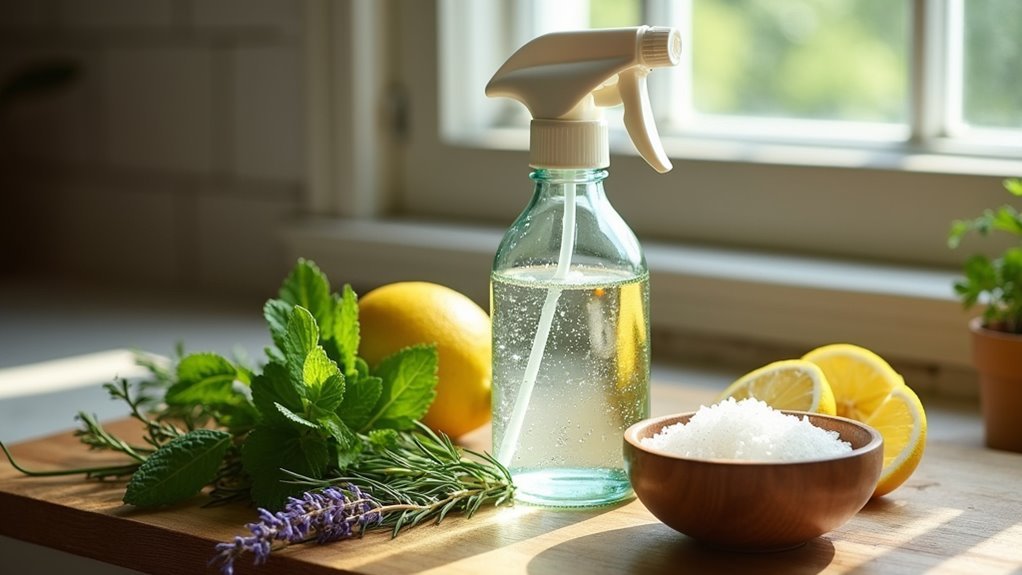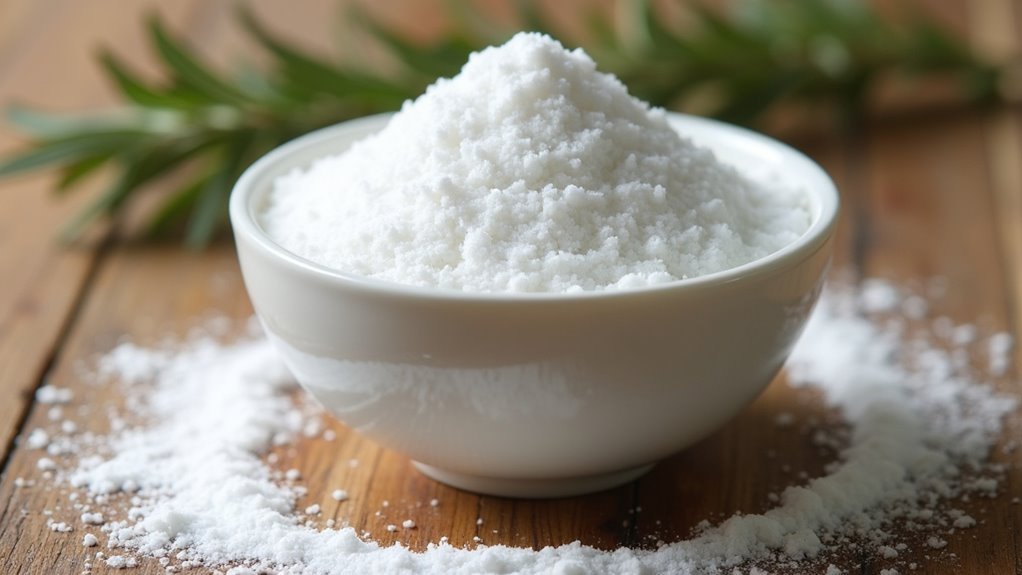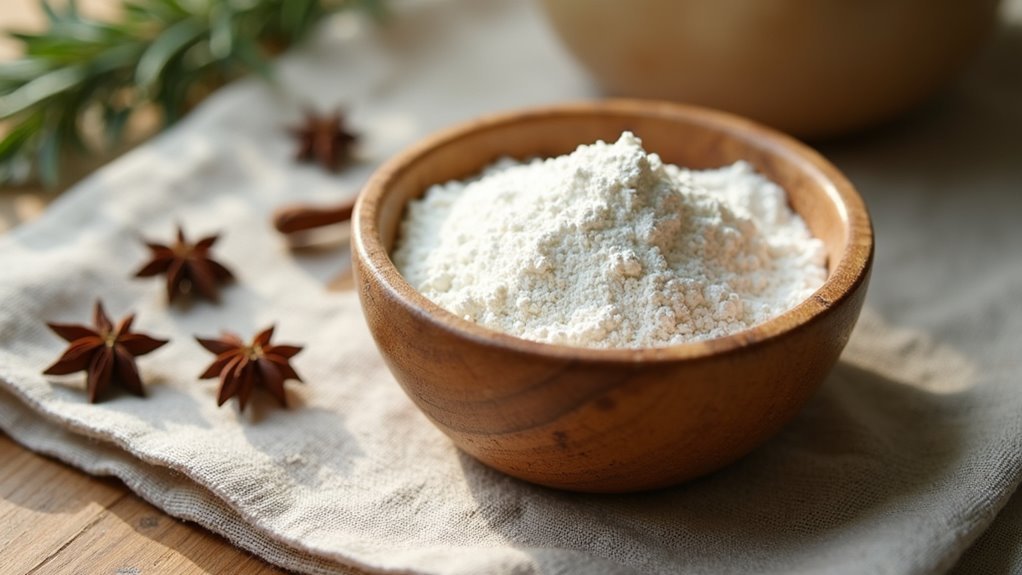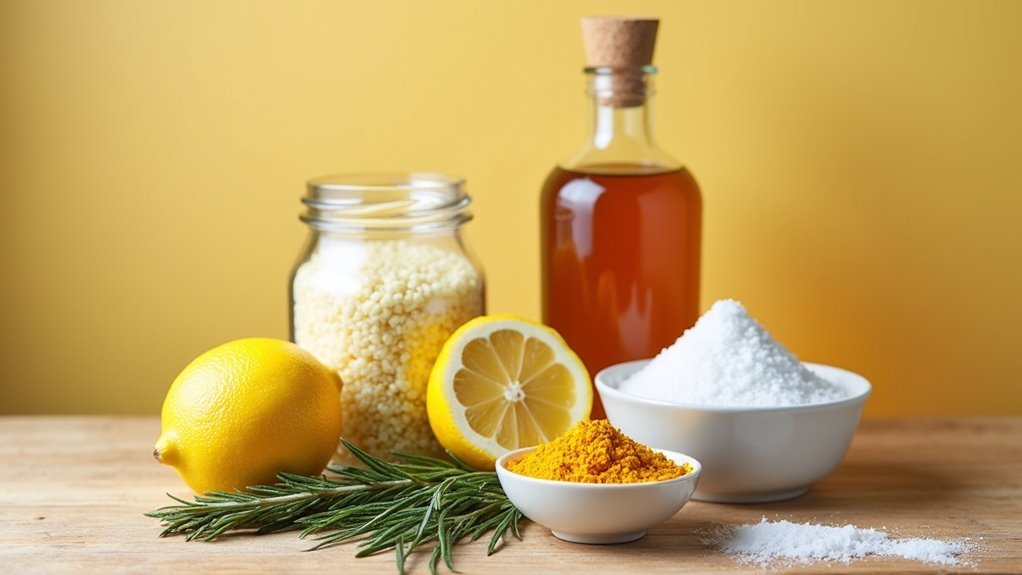You can tackle fleas using everyday pantry items like salt and baking soda, which dehydrate adult fleas and eggs when sprinkled on carpets for 24 hours before vacuuming. Create dish soap traps with warm water to catch active fleas overnight, or mix equal parts vinegar and water to spray on pet bedding and furniture. Dawn dish soap works as an effective pet shampoo that suffocates fleas on contact. These natural methods offer extensive flea control strategies for your entire household.
Vinegar Solution for Flea Repellent

When fleas invade your home, you don’t need expensive commercial sprays to fight back effectively. A simple vinegar solution serves as a powerful natural flea repellent that’s both safe and affordable.
Mix equal parts distilled white vinegar or apple cider vinegar with water in a spray bottle for easy application.
Target areas where fleas commonly hide, including pet bedding, carpets, and upholstered furniture. The strong smell and taste repel fleas naturally.
For enhanced results, use a cloth dampened with the solution to wipe surfaces, helping remove fleas and their eggs directly.
This cost-effective flea control method poses minimal risk to pets and humans. Regular application supports ongoing flea management as part of a holistic approach to household pest control.
Salt Treatment for Carpet Areas
While commercial flea treatments can drain your wallet, salt offers an incredibly effective and budget-friendly alternative for targeting carpet infestations. This common household item works as a powerful desiccant, dehydrating both adult fleas and their eggs when sprinkled liberally across affected areas.
Use finely ground salt for maximum penetration into your carpet fibers. Allow it to sit for at least 24 hours before vacuuming to guarantee thorough dehydration of hidden pests. This waiting period is essential for the salt to effectively eliminate fleas at all life stages.
Fine salt penetrates carpet fibers deeply – let it work for 24 hours to dehydrate fleas at every life stage.
After vacuuming, dispose of the bag or empty the canister outside your home immediately.
Regular salt applications combined with consistent cleaning practices will help maintain a flea-free environment and prevent future infestations.
Baking Soda Application Method

Baking soda delivers another powerful pantry solution that works similarly to salt but offers the added benefit of being completely safe around children and pets.
This desiccant dehydrates fleas and their eggs on contact, making it an excellent non-toxic flea control method.
For maximum effectiveness, sprinkle baking soda liberally across affected areas and let it sit for at least 24 hours.
Then vacuum thoroughly afterwards to remove the baking soda along with dead fleas and eggs. Always dispose of vacuum contents outside to prevent reinfestation.
Key application tips:
- Allow 24+ hours of contact time before vacuuming
- Focus on areas where pets and children spend time
- Dispose of vacuum contents outdoors immediately
Regular application combined with consistent vacuuming will reduce flea populations considerably over time.
Dish Soap Flea Traps
Simple dish soap creates one of the most effective and affordable flea traps you can make from household items.
Mix warm water with dishwashing liquid in a bowl or plate, then place it near areas where you’ve noticed flea activity. The soap breaks water’s surface tension, causing adult fleas to sink and drown when they jump into the soapy water instead of floating away.
Dish soap eliminates water’s surface tension, trapping jumping fleas that would otherwise bounce off and escape the water.
Set these dish soap flea traps overnight when fleas are most active for ideal results. You’ll need to dispose of captured fleas and refresh the solution nightly to maintain effectiveness.
Remember that these traps only capture fleas and don’t eliminate flea eggs or larvae, so combine them with other flea control methods for thorough pest management.
Diatomaceous Earth Powder Treatment

Though it may sound like a complex chemical, diatomaceous earth is actually a natural powder made from fossilized remains of tiny aquatic organisms called diatoms.
This food-grade powder works as one of the most effective natural remedies for flea infestations by dehydrating fleas on contact.
When you sprinkle the powder on carpets, pet’s bedding, and infested areas, it absorbs moisture from flea exoskeletons, causing death within four hours.
It’s safe around pets and humans, making it ideal for households seeking non-toxic solutions.
Application Tips:
- Leave DE for 24 hours before vacuuming to maximize efficiency
- Apply thin layers to avoid waste and guarantee proper coverage
- Reapply regularly to disrupt the flea life cycle and kill fleas at all stages
Essential Oil Spray Combinations
When you’re looking for gentle yet effective flea control, essential oil spray combinations offer a natural alternative that’s safe for most households. You’ll need 10-15 drops of essential oils like rosemary, lavender, peppermint, or cedarwood mixed with 2 cups of water in a spray bottle. Always shake thoroughly before each use.
| Essential Oil | Dilution Ratio | Best Application |
|---|---|---|
| Rosemary | 1 drop per tsp carrier oil | Pet bedding |
| Cedarwood | 1 drop per tsp carrier oil | Home surfaces |
| Lemon | Infused in water | Natural flea spray |
| Lavender | 1 drop per tsp carrier oil | General areas |
| Peppermint | 1 drop per tsp carrier oil | Entry points |
Use diluted essential oil to prevent skin irritation. You can also create lemon juice sprays for pet bedding. Always avoid pets’ eyes and seek vet consultation for sensitive animals, especially cats.
Citrus-Based Flea Deterrent
Because citrus peels and juices contain limonene—a compound that disrupts fleas’ nervous systems—you can create powerful deterrent sprays using ingredients already in your kitchen.
These citrus-based flea deterrents harness the natural repelling power of citrus scent to keep pests away from your home and pets.
To make effective lemon spray, mix 1/4 cup fresh lemon juice with 2 cups water. For stronger potency, steep lemon slices in boiling water overnight before straining.
You can safely use this natural repellent on pets bedding or apply directly to pets, avoiding their eyes.
- Easy preparation: Simple kitchen ingredients create effective repelling fleas solutions
- Safe application: Gentle enough for pets bedding and direct pet contact
- Long-term protection: Regular application maintains a flea-free environment naturally
Apple Cider Vinegar for Pet Bathing
You’ll find apple cider vinegar works as an effective flea repellent when you mix it properly for your pet’s bath.
The key is getting the dilution right – combine one part ACV with three parts water to create a solution that’s strong enough to repel fleas but gentle on your pet’s skin.
When applying this mixture, focus on thorough coverage while carefully avoiding your pet’s eyes to prevent irritation from the acidity.
Proper Dilution Ratios
Two critical ratios determine the safety and effectiveness of apple cider vinegar baths for your pet.
For standard pet bathing, mix one part apple cider vinegar with two parts water. This dilution provides peak flea-deterring benefits while protecting your pet’s skin from irritation.
If your pet has sensitive skin or allergies, you’ll need a gentler approach. Use one part apple cider vinegar to three parts water instead. This weaker vinegar solution reduces potential skin reactions while maintaining coat health benefits.
- Avoid applying the solution near eyes, ears, and open wounds
- Always rinse thoroughly with water after bathing to prevent dryness
- Regular use helps maintain healthy coats and naturally deters fleas
Proper dilution guarantees your pantry remedy works effectively without harming your furry friend.
Application Techniques
Once you’ve prepared your diluted apple cider vinegar solution, start by wetting your pet’s coat thoroughly with warm water.
Apply the mixture evenly across your pet’s fur, working it in with your hands to guarantee complete coverage. The apple cider vinegar will help repel fleas while promoting skin health.
Let the solution sit for several minutes to maximize effectiveness before rinsing thoroughly. When bathing your pet, be especially careful around sensitive skin areas and always test on a small patch first.
This technique works best as part of extensive preventative measures against flea infestations. Regular application during baths can maintain your pet’s coat condition while naturally deterring pests through the vinegar’s strong scent and taste properties.
Boric Acid Targeted Application
Strategic placement makes boric acid one of the most effective flea-fighting tools in your pantry arsenal. This desiccant works by dehydrating fleas and their eggs when they crawl through and ingest the powder.
Focus your application on carpets, cracks, and crevices where fleas commonly hide in infested areas.
Key application strategies:
- Dust a fine layer across targeted zones, avoiding food preparation surfaces due to slight toxicity
- Wear a mask during application and keep children and pets away until powder settles
- Vacuum treated areas after 1-2 days to remove dead fleas, then reapply as needed
Dawn Dish Soap Pet Shampoo
While boric acid targets fleas in your environment, Dawn dish soap offers a direct solution for treating infested pets. This effective natural remedy works by breaking down adult fleas’ exoskeletons, suffocating them on contact.
You can create a homemade pet shampoo by mixing one tablespoon of Dawn with four cups of water in a squirt bottle.
When applying this safe to use solution, carefully avoid your pet’s eyes to prevent irritation. Leave on the soapy mixture for 5-10 minutes to maximize flea-killing effectiveness, then rinse thoroughly with clean water.
While Dawn provides excellent results, don’t use it too frequently as it can strip your pet’s natural skin oils, potentially causing dryness or irritation with overuse.
Frequently Asked Questions
What Is an Instant Homemade Flea Killer?
You can create an instant homemade flea killer by mixing equal parts water and distilled white vinegar in a spray bottle. The strong scent and taste will repel fleas immediately.
What Do Fleas Hate the Most on Humans?
Fleas hate strong essential oil scents like peppermint, rosemary, and lavender on your skin. They’ll also avoid you if you’re wearing citrus-scented oils or apple cider vinegar spray as natural repellents.
How to Quickly Get Rid of Fleas in the House?
You’ll quickly eliminate fleas by vacuuming daily, sprinkling salt on carpets overnight, spraying vinegar-water solution on furniture, setting dish soap traps, and washing all bedding in hot water immediately.
Do Baking Soda and Salt Really Kill Fleas?
Yes, you’ll find that baking soda and salt effectively kill fleas by acting as desiccants. They’ll dehydrate adult fleas and eggs within 24 hours when you sprinkle them liberally on carpets and bedding.
In Summary
You’ve now got ten powerful flea-fighting solutions right at your fingertips. Don’t wait for the problem to worsen—start treating affected areas immediately with these pantry staples. Remember, consistency’s key when battling fleas, so you’ll need to repeat treatments regularly. Combine multiple methods for maximum effectiveness, and always test small areas first. With persistence and these natural remedies, you’ll reclaim your home from these persistent pests without breaking the bank.





Leave a Reply